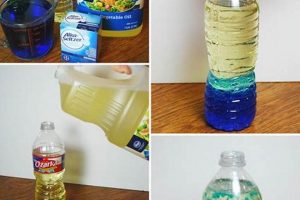A system enabling plants to hydrate independently using a reservoir of water is an innovative gardening solution. This mechanism often utilizes capillary action, wicking water from the reservoir into the soil as needed, maintaining optimal moisture levels. An example includes repurposing a plastic bottle inverted into a soil-filled container, with the bottle’s neck submerged in a water-filled base.
This automated watering approach offers numerous advantages. It reduces the frequency of manual watering, conserving water and minimizing the risk of over or under-watering. This is particularly beneficial for individuals with busy schedules or those residing in areas with water restrictions. Historically, variations of this system have been employed in agriculture to improve crop yields and resource management.
The subsequent sections will explore the diverse methods for constructing these systems, examine suitable materials for their creation, and provide guidance on selecting plants that thrive within this environment. Further discussion will center on troubleshooting common issues and optimizing the system for various plant types and settings.
Tips for Effective Automated Plant Hydration Systems
Optimal performance of an automated plant hydration system requires careful consideration of several key factors. These tips provide guidance on maximizing the efficiency and longevity of such systems.
Tip 1: Material Selection: The choice of materials for reservoir construction significantly impacts system durability and safety. Opt for food-grade plastics or glazed ceramics to avoid leaching harmful chemicals into the soil.
Tip 2: Soil Composition: Soil type influences water wicking and retention. Incorporate materials like perlite or vermiculite to improve drainage and prevent waterlogging, particularly when utilizing a continuous hydration system.
Tip 3: Wicking Medium: The wicking medium connecting the reservoir to the soil is crucial for regulated water delivery. Experiment with materials like cotton rope, felt strips, or nylon wicks to determine optimal flow rates for specific plant needs.
Tip 4: Reservoir Size: Calculate reservoir volume based on plant size, species, and environmental conditions. Larger plants and hotter climates necessitate larger reservoirs to maintain adequate hydration between refills.
Tip 5: Placement and Sun Exposure: Account for sun exposure and ambient temperature when positioning the system. Excessive heat may increase water evaporation, requiring more frequent reservoir refills or shading of the system.
Tip 6: Monitoring and Adjustment: Regularly inspect the system for clogs, leaks, or algae growth. Adjust wicking material or reservoir size as needed to maintain consistent soil moisture levels.
Tip 7: Plant Selection: Not all plants are suitable for automated hydration systems. Research species-specific water requirements and select plants that tolerate consistent moisture, such as herbs, leafy greens, or moisture-loving flowers.
Implementing these tips will lead to a more efficient and reliable automated plant hydration system, promoting healthy plant growth and reducing the need for manual intervention.
The following section will provide insights into adapting these systems for diverse environmental conditions and specific plant varieties.
1. Reservoir Capacity
Reservoir capacity within a automated plant hydration system is directly correlated with the system’s operational efficiency and the plant’s well-being. A larger reservoir provides an extended period of autonomous watering, mitigating the need for frequent manual intervention. The volume should be proportional to the plant’s water consumption rate, considering factors such as plant size, species, and environmental conditions, particularly temperature and humidity. Insufficient capacity results in water stress, inhibiting growth and potentially leading to plant decline. Conversely, an excessively large reservoir in conjunction with slow-draining soil may induce waterlogging, promoting root rot and other fungal diseases. For example, a small succulent requires a significantly smaller reservoir than a tomato plant cultivated under full sun.
Accurate assessment of plant-specific water requirements is thus paramount in determining the appropriate reservoir size. Data regarding typical watering schedules for similar plant species, coupled with observation of plant turgor pressure, can inform this determination. Furthermore, incorporating transparent reservoirs facilitates visual monitoring of water levels, enabling timely refills and preventing catastrophic depletion. Integration of automated refill mechanisms, such as float valves connected to a water source, represents an advanced approach to maintaining consistent hydration. This automation is particularly beneficial for individuals with limited availability for plant care, or for maintaining indoor plant displays in commercial settings.
In summary, reservoir capacity is a critical design parameter in automated plant hydration. Proper sizing, achieved through careful consideration of plant needs and environmental factors, ensures consistent moisture availability, promoting robust plant health and minimizing maintenance requirements. Challenges associated with inaccurate estimations can be addressed through continuous monitoring and adaptive adjustments. The overall effectiveness of automated watering is inherently linked to this foundational element.
2. Wicking Material
The wicking material serves as the critical conduit between the water reservoir and the soil in a automated plant hydration system. Its properties directly impact the rate and consistency of moisture delivery, influencing plant health and system efficacy.
- Capillary Action and Material Properties
Capillary action, the ability of a liquid to flow in narrow spaces against the force of gravity, is the fundamental principle governing wicking. The choice of wicking material dictates the efficiency of this process. Materials with high porosity and surface area, such as cotton, felt, or certain synthetic fabrics, exhibit superior capillary action. For example, tightly woven cotton rope provides a reliable and consistent water flow, whereas less porous materials may result in inadequate hydration.
- Material Degradation and Longevity
The long-term performance of the system is dependent on the wicking material’s resistance to degradation. Organic materials, like cotton, are susceptible to decomposition from microbial activity and mineral buildup, potentially impeding water flow over time. Synthetic materials, while often more durable, may be prone to clogging due to sediment accumulation. Regular inspection and periodic replacement of the wicking material are essential maintenance practices. Consider using treated mater
ials designed to resist degradation, though ensure any treatment is plant-safe. - Influence on Soil Moisture Distribution
The wicking material influences the spatial distribution of moisture within the soil. A single wick placed at the bottom of the container will primarily hydrate the lower soil layers, potentially leading to uneven moisture distribution. Employing multiple wicks or a wicking mat can facilitate a more uniform saturation of the soil profile. The length and diameter of the wick also affect the area of influence; longer or thicker wicks generally hydrate a larger soil volume, but careful calibration is necessary to avoid oversaturation in localized zones.
- Material Safety and Plant Compatibility
The selected wicking material must be inert and non-toxic to avoid contaminating the soil or harming the plant. Certain synthetic materials may leach chemicals into the water or soil, negatively affecting plant growth. Natural materials, like untreated hemp or jute, are generally considered safe alternatives. Before implementing any wicking material, verify its compatibility with the specific plant species being cultivated.
Wicking material is integral to the successful operation of a automated plant hydration system. The appropriate selection, installation, and maintenance of this component directly impact the system’s ability to provide consistent and safe hydration, leading to healthy plant growth. Consideration of material properties, longevity, moisture distribution, and safety is paramount for optimal system performance.
3. Soil Composition
Soil composition is a critical determinant of success within a automated plant hydration system. It directly influences water retention, drainage, and aeration, impacting root health and overall plant vigor.
- Water Retention Capacity
Different soil components possess varying water retention capacities. Clay particles, for instance, exhibit high water retention, potentially leading to waterlogging in a closed system. Conversely, sandy soils drain rapidly, potentially resulting in insufficient hydration. The ideal soil mix for automated systems balances water retention with adequate drainage. Incorporation of amendments like peat moss or coconut coir increases water retention in sandy soils, while perlite or vermiculite enhances drainage in clay-heavy mixes. An example would be a mix of equal parts loam, perlite, and compost for general purpose use.
- Aeration and Root Health
Adequate aeration is essential for root respiration and nutrient uptake. Compacted soils restrict oxygen availability, hindering root development and increasing susceptibility to root rot. Components like perlite, vermiculite, and bark chips create air pockets within the soil matrix, promoting aeration. Coarse-textured amendments also improve drainage, preventing waterlogged conditions that inhibit oxygen diffusion. For example, orchids, which require excellent aeration, benefit from a soil mix containing a significant proportion of bark chips.
- Nutrient Availability and pH Balance
Soil composition affects nutrient availability and pH levels, influencing plant nutrient uptake. Organic matter, such as compost or aged manure, provides essential nutrients and improves soil structure. The pH level impacts the solubility of nutrients, with certain nutrients becoming less available at extreme pH values. Maintaining a balanced pH, typically between 6.0 and 7.0 for most plants, optimizes nutrient uptake. Regular soil testing enables monitoring of nutrient levels and pH, allowing for targeted amendments to address deficiencies or imbalances. For example, blueberries require acidic soil, necessitating the addition of sulfur or peat moss to lower the pH.
- Wicking Efficiency
The soil’s texture and structure influence the efficacy of the wicking mechanism. Fine-textured soils with high capillarity facilitate efficient water transport from the reservoir to the plant roots. However, excessively dense soils can impede water flow and reduce aeration. Incorporating coarse-textured amendments, such as sand or gravel, can improve drainage and prevent compaction, promoting consistent wicking. Additionally, the uniformity of the soil mix is crucial; layering different soil types can disrupt water flow and lead to uneven hydration. Consistent blending of soil components ensures uniform moisture distribution throughout the container. For example, a well-blended mixture prevents the formation of dry pockets or waterlogged zones.
The interplay between soil composition and the self-watering mechanism dictates the success of this horticultural method. Attentive selection of soil components, tailored to the specific needs of the plant and the system’s design, ensures optimal hydration, aeration, and nutrient availability. Consistent monitoring and adaptive adjustments to the soil mix facilitate robust plant growth and sustainable resource utilization within a automated plant hydration environment.
4. Plant Selection
Appropriate plant selection is paramount for optimal functionality of automated plant hydration systems. Matching plant needs to the system’s capabilities ensures healthy growth and minimizes potential issues. The following considerations detail crucial aspects of plant selection within this context.
- Water Requirement Compatibility
Plant species exhibit varying water requirements. Selecting species suited for consistently moist conditions is crucial. Plants requiring frequent drying periods are prone to root rot in automated systems. For example, succulents and cacti generally do not thrive in these environments due to their need for dry soil between waterings. Conversely, herbs like mint and basil, which prefer consistently moist soil, are often well-suited.
- Root System Characteristics
The depth and density of a plant’s root system influence its ability to access water from the system’s wicking mechanism. Plants with shallow root systems may not effectively draw water from the reservoir, necessitating adjustments to the wick placement or soil composition. Plants with aggressive root systems may clog the system over time, requiring periodic maintenance. African Violets, for example, possess relatively shallow root systems that benefit from wicking systems providing consistent surface moisture.
- Light and Environmental Considerations
Matching a plant’s light requirements to the available environment is critical, regardless of the watering system. However, improper light can exacerbate watering issues in automated systems. Plants in low-light conditions require less water; thus, an automated system may overwater them, leading to problems. Conversely, plants in high-light conditions may deplete the reservoir too quickly, necessitating larger reservoirs or more frequent refills. Leafy greens like spinach can be cultivated indoors with grow lights in automated systems, requiring careful monitoring to prevent over or underwatering based on light intensity.
- Nutrient Needs and System Management
Different plant species have varying nutrient requirements. While automated systems primarily address water delivery, soil composition and supplemental fertilization remain important. Plants with high nutrient demands may
deplete soil nutrients rapidly, necessitating regular fertilization. Selecting slow-release fertilizers or incorporating compost into the soil mix can help maintain nutrient levels. Monitoring plant health and adjusting fertilization practices are crucial for sustained growth within the system.
In conclusion, selecting plant species congruent with the capabilities and limitations of automated hydration is a fundamental element of success. Careful consideration of water requirements, root system characteristics, light exposure, and nutrient demands is essential for sustained plant health and efficient system operation. Matching plants to system capabilities minimizes the need for intervention and promotes a thriving automated gardening environment.
5. Environmental Factors
Environmental factors exert a significant influence on the performance and effectiveness of automated plant hydration systems. Understanding and managing these external conditions is crucial for maintaining optimal plant health and system efficiency.
- Temperature and Evaporation Rate
Ambient temperature directly impacts the rate of water evaporation from both the soil surface and the reservoir. Higher temperatures accelerate evaporation, leading to increased water demand and potentially depleting the reservoir prematurely. Conversely, lower temperatures reduce evaporation, potentially resulting in waterlogged soil conditions, especially in poorly drained systems. In warmer climates, shading the reservoir and using insulated containers can mitigate excessive evaporation. For cooler environments, adjusting the wicking material or reducing reservoir size may be necessary to prevent overwatering. For instance, systems placed on a sunny balcony will require more frequent monitoring and potentially larger reservoirs than those kept indoors at a stable temperature.
- Humidity Levels
Air humidity affects transpiration rates in plants. High humidity reduces transpiration, decreasing the plant’s water uptake. In such environments, systems may need to be adjusted to deliver less water to avoid over saturation. Low humidity, on the other hand, increases transpiration, resulting in higher water demand. During dry seasons or in arid climates, a larger reservoir and a more efficient wicking system may be necessary. Consider the contrast between plants grown in a humid greenhouse versus a dry office environment; the latter will require a more robust automated watering solution.
- Light Intensity and Duration
Light intensity and duration influence plant growth and water consumption. Plants exposed to high light levels typically exhibit increased photosynthetic activity and transpiration rates, requiring more frequent watering. Conversely, plants in low-light conditions require less water. Systems located near windows or under grow lights may need to be adjusted to accommodate these varying needs. For example, a plant receiving direct sunlight for several hours each day will require a larger water supply and potentially a faster wicking rate compared to a plant situated in a shaded corner.
- Airflow and Ventilation
Airflow and ventilation affect the rate of moisture evaporation from the soil surface. Adequate airflow promotes healthy root development but can also accelerate water loss. Poor ventilation can lead to increased humidity and fungal diseases. Systems placed in well-ventilated areas may require larger reservoirs or more frequent refills. Conversely, systems in enclosed spaces may benefit from reduced watering intervals or improved drainage. Consider the difference between a plant situated in a drafty hallway versus one in a sealed container; each environment presents unique watering challenges.
In essence, the effectiveness of any automated plant hydration system is inextricably linked to the surrounding environment. Careful consideration of temperature, humidity, light intensity, and airflow is essential for optimizing system performance and promoting robust plant growth. These factors necessitate continual observation and adaptive adjustments to ensure sustainable hydration within varying environmental contexts.
6. System Maintenance
DIY self-watering planter systems, while designed to automate plant hydration, inherently require consistent maintenance to ensure optimal functionality and prevent complications. Neglecting maintenance routines can lead to reduced efficiency, plant health issues, and eventual system failure. The relationship between these planters and system maintenance is causal: inadequate maintenance directly causes performance degradation, whereas regular upkeep sustains the system’s intended benefits.
Maintenance protocols encompass several key areas. First, the water reservoir requires periodic cleaning to prevent algae growth and sediment accumulation, both of which can impede water flow and contaminate the soil. For instance, algae buildup can physically block the wicking material, effectively halting water delivery. Second, the wicking material itself must be monitored for clogging or degradation. Organic materials, such as cotton, are susceptible to decomposition, which can diminish their wicking capacity. Third, the soil should be inspected for compaction or nutrient depletion. Compacted soil restricts root growth and reduces water absorption, while nutrient deficiencies impact plant health. Regular flushing of the soil helps remove accumulated salts and maintain optimal soil conditions. Furthermore, the planter’s physical structure should be examined for leaks or damage, which can lead to water loss and system inefficiency. A cracked reservoir, for example, can negate the self-watering feature entirely.
Effective system maintenance ensures long-term viability and maximizes the benefits of DIY self-watering planters. Addressing potential issues proactively prevents escalating problems and minimizes the need for costly repairs or replacements. By adhering to a regular maintenance schedule, users can sustain healthy plant growth and enjoy the convenience and water-saving advantages of these automated hydration systems. The practical significance of this understanding lies in preserving the initial investment and promoting sustainable gardening practices.
Frequently Asked Questions About DIY Self-Watering Planters
This section addresses common inquiries and clarifies potential misconceptions regarding the construction and utilization of DIY self-watering planters.
Question 1: What types of plants are most suitable for DIY self-watering planters?
Plants that thrive in consistently moist soil conditions, such as herbs (mint, basil), leafy greens (lettuce, spinach), and certain flowers (African violets), are generally well-suited. Avoid species requiring dry periods between waterings, such as succulents and cacti.
Question 2: What materials are recommended for constructing a DIY self-watering planter?
Food-grade plastic containers, repurposed buckets, and ceramic pots are suitable reservoir materials. Wicking materials include cotton rope, felt strips, and nylon cords. Soil mixes should balance water retention and drainage, incorporating perlite, vermiculite, and compost.
Question 3: How often should the water reservoir be refilled?
Refill frequency depends on pla
nt size, species, environmental conditions (temperature, humidity), and reservoir capacity. Regular monitoring of water levels is essential. Visual inspection is preferred over relying on a fixed schedule.
Question 4: Can fertilizer be used in a DIY self-watering planter?
Yes, but caution is warranted. Slow-release fertilizers or diluted liquid fertilizers are preferable to avoid salt buildup in the soil. Monitor plant health and adjust fertilization accordingly.
Question 5: What are common problems encountered with DIY self-watering planters?
Algae growth in the reservoir, clogging of the wicking material, root rot due to overwatering, and nutrient deficiencies are common issues. Regular maintenance and appropriate plant selection can mitigate these problems.
Question 6: How does soil composition affect the performance of a DIY self-watering planter?
Soil composition significantly influences water retention, drainage, and aeration. A well-balanced soil mix promotes healthy root development and efficient water uptake. Adjustments to the soil mix may be necessary based on the specific plant species being cultivated.
Successfully employing these planters involves thoughtful planning and consistent monitoring to ensure optimal plant health and system functionality.
The following section will address advanced techniques for customizing these systems for specific plant needs and environmental contexts.
DIY Self Watering Planters
The preceding analysis has explored the multifaceted aspects of DIY self watering planters. From fundamental construction techniques to the critical roles of material selection, soil composition, and plant compatibility, the components necessary for effective automated plant hydration have been examined. Moreover, the influence of environmental factors and the importance of consistent system maintenance have been underscored.
The implementation of these systems necessitates a commitment to informed design and diligent upkeep. While offering the potential for reduced manual intervention and efficient water management, successful utilization hinges on a thorough understanding of plant-specific requirements and the dynamic interplay of environmental variables. Further research and adaptive application remain essential for optimizing the performance and longevity of DIY self watering planter systems in diverse horticultural settings.







